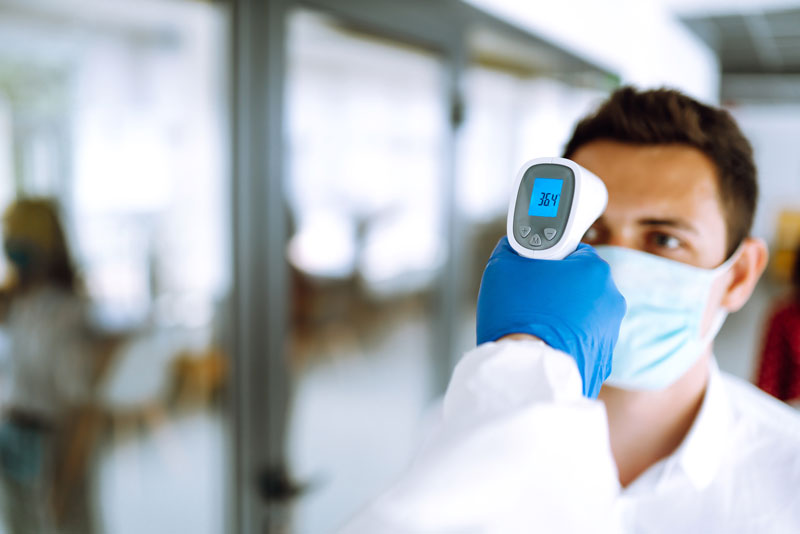The following summary comes from CDC guidelines. More detailed explanations may be found in our Exposure & Risk-assessment Guidelines and from the CDC website.
STEP 1 – BE PROACTIVE
In the vast majority of cases, employees are becoming infected at home and in social interactions – NOT on the job. Discuss the responsibility all health care workers have to practice social distancing, hand washing, and especially wear of facial covering in all social situations away from work.
STEP 2 – CONFIRM THE INFECTION
- Outside the office:
- If a doctor or employee has symptoms or reports a prolonged exposure to an individual with confirmed COVID-19 outside the office, the doctor or employee should be tested.
- Inside the office:
- If the doctor or employee has a prolonged exposure inside the office and was not wearing a mask, they should be tested.
- If the doctor or employee has a prolonged exposure inside the office and both the infected individual and exposed individual were wearing masks, no testing is required.
*NOTE: “Prolonged exposure” is defined by the CDC as: Someone who was within 6 feet of an infected person for a cumulative total of 15 minutes or more over a 24-hour period starting from 2 days before illness onset (or, for asymptomatic patients, 2 days prior to test specimen collection) until the time the patient is isolated.
STEP 3 – NOTIFICATIONS
While you may choose to do so, there is no directive to notify your potentially exposed patient base as long as all doctors, employees, and patients were wearing masks. Contact tracing is the function of the state and local health departments and is performed anonymously. If you choose to notify patients, provide the least amount of information necessary, and never release any patient names. Follow HIPAA guidelines for secured privacy communications. If you need to place signage at your location during temporary closure or disinfection, recommended language could be:
“In order to provide the safest environment for our patients, we are temporarily closed to perform additional disinfection and safety measures.”
Also, be careful when discussing the issue with staff. The Americans with Disabilities Act (ADA) privacy rules restrict employers from sharing personal health information of an employee. Employers should inform employees that possible exposure has occurred in the workplace without disclosing any identifying information about the individual who tested positive. In a small office, it is almost certain the staff will deduce who has contracted COVID, but the employer should not identify the employee.
STEP 4 – ENSURE DISINFECTION
Steps should be taken to thoroughly disinfect the office with special attention to any areas the suspect or confirmed individual visited. It is recommended but not required that those areas be closed off for 24 hours. Special air filtration or UV sterilization can also be beneficial.
Although an option, there is no requirement that the office be disinfected by a professional company.
STEP 5 – ESTABLISH RETURN TO WORK PROTOCOLS
Criteria for back to work requirements can be complex depending on the nature of the exposure and whether or not the individual is symptomatic or not, see our detailed recommendations here. The following is a recommended simplified approach.
Symptom-based strategy for determining when HCP can return to work.
HCP with mild to moderate illness who are not severely immunocompromised:
- At least 10 days have passed since symptoms first appeared and
- At least 24 hours since last fever (w/o use of fever-reducing medications) and
- Symptoms (e.g., cough, shortness of breath) have improved
* note there are stricter requirements for severe cases or immunocompromised HCP
Test-Based Strategy for Determining when HCP Can Return to Work.
In some instances, a test-based strategy could be considered to allow HCP to return to work earlier than if the symptom-based strategy were used. The criteria for the test-based strategy are:
HCP who are symptomatic:
- Resolution of fever without the use of fever-reducing medications and
- Improvement in symptoms (e.g., cough, shortness of breath), and
- Results are negative from at least two consecutive respiratory specimens collected ≥24 hours apart (total of two negative specimens) tested using an FDA-authorized molecular viral assay.
HCP who are not symptomatic:
- Results are negative from at least two consecutive respiratory specimens collected ≥24 hours apart (total of two negative specimens) tested using an FDA-authorized molecular viral assay.
In addition to these recommendations, be sure to remain aware of and follow all unique state and local guidelines.

